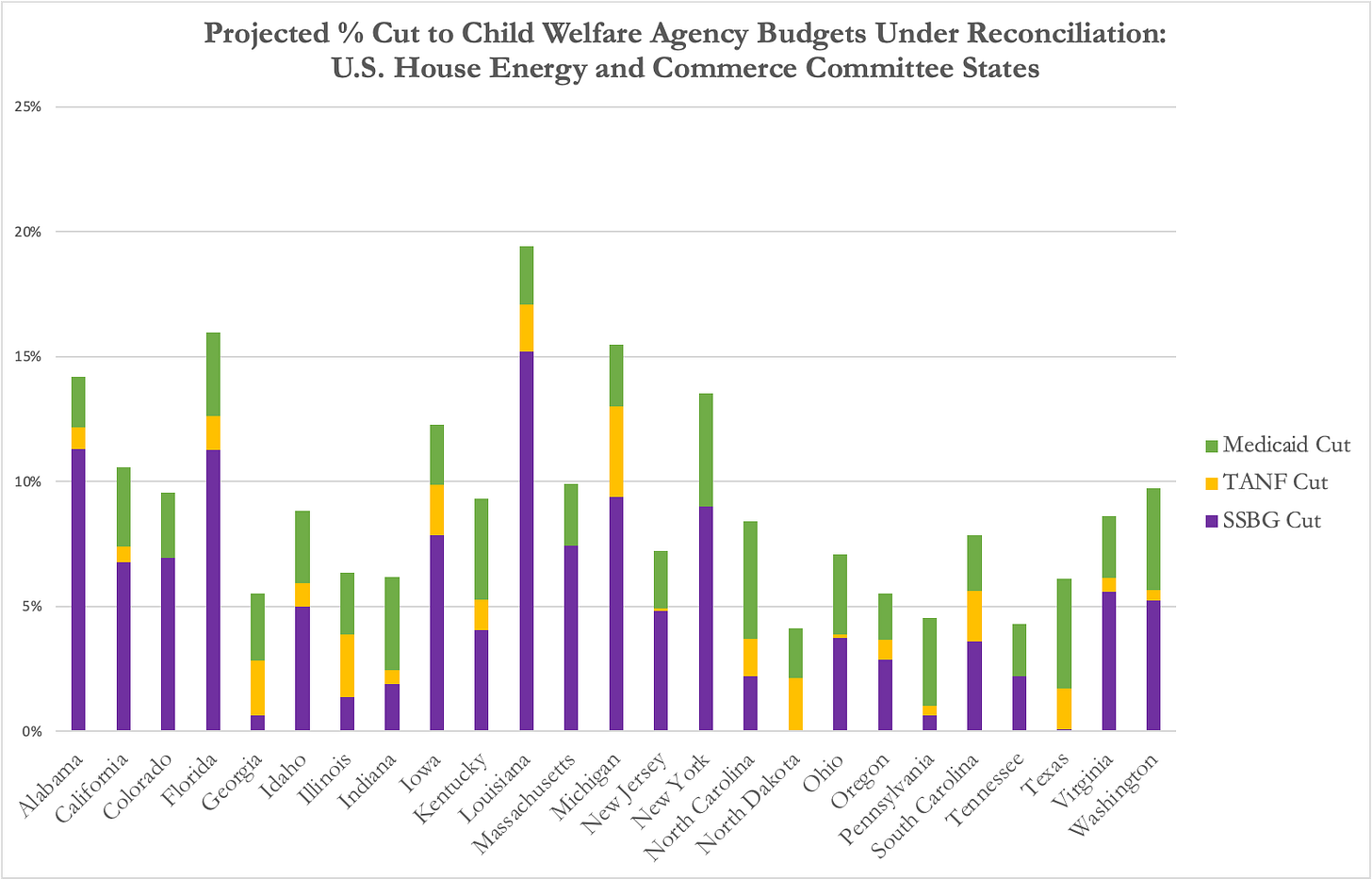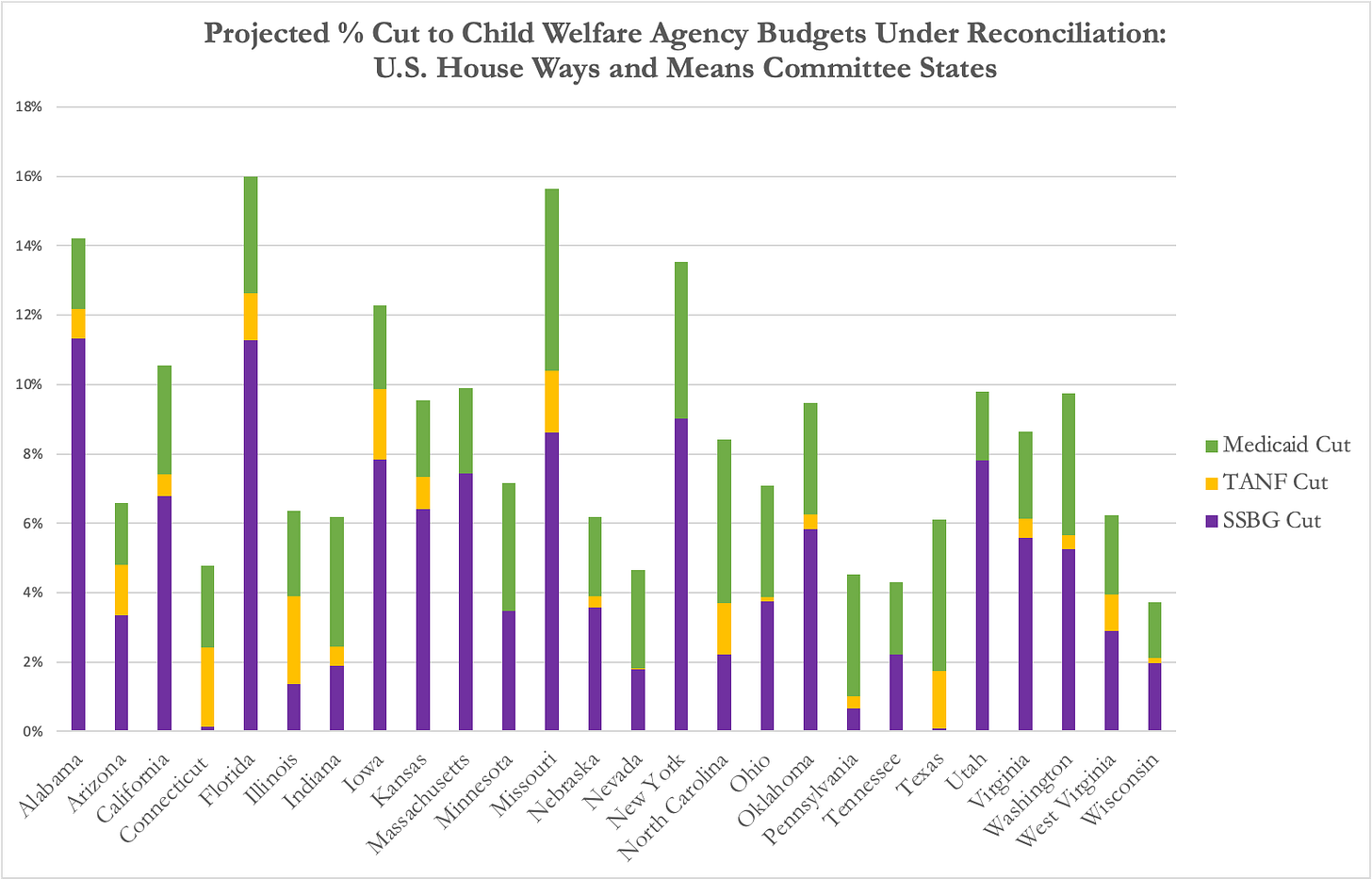Reconciliation Hits "The Stall"
Budgetary brisket, and so much more
Welcome, Wonks!
We’re evolving from newsletter to full strategic policy intelligence platform.
Thanks to partners, our newsletter stays free. The analysis and new offerings get sharper, deeper, and even more essential.
Worth Watching: On April 29, the LA County Board of Supervisors approved 4-0 a $4B settlement for claims of sexual abuse in foster care and juvenile detention.
Covering almost 7,000 claims dating back to 1959, the settlement is the largest of its kind. It’s 60 percent larger than the Boy Scouts of America’s nationwide settlement.
This shifts the policy ground. We warned of a looming liability crisis; CA is facing it.
This Week: This week we’ve got the President’s FY26 budget request, regulatory updates, reconciliation news, and analysis of what’s on the horizon.
Let’s get after it, Wonks.
Featured Child Welfare Wonk Partner:
The Dave Thomas Foundation for Adoption is a national, nonprofit public charity dedicated to finding permanent homes for the more than 140,000 children waiting in North America’s foster care systems. Created by Wendy’s® founder Dave Thomas who was adopted, the Foundation implements evidence-based, results-driven national service programs, foster care adoption awareness campaigns and innovative grantmaking. To learn more, visit davethomasfoundation.org.
Skinny Budget Shrinks Spending
On May 2 President Trump released summaries of the FY26 President’s Budget Request that would significantly cut domestic program funding.
Overview: The budget is a non-binding appropriations request to Congress.
It’s a key policy priorities document, especially in an administration’s first year.
This summary version is the so-called “skinny budget”.
Skinny Budget Overview: Broad strokes now, details come later.
FY26 Skinny Budget in Context: Congress decides discretionary spending annually. Mandatory spending is locked in. This budget calls for significant cuts to the former.
The budget would cut non-defense discretionary spending by $163B, or nearly 23%.
The proposal would create a new $500M Make America Healthy Again initiative. Overall it would significantly cut a wide array of health and human services programs.
Child Welfare Implications: No granular data yet for most HHS Administration for Children and Families (ACF) programs.
There are several dynamics with important implications:
Shifts economic development and anti-poverty work to states.
Eliminates the $3.3B Community Development Block Grant (CDBG) and $770M Community Services Block Grant (CSBG).
CDBG supports locally-driven economic development projects
CSBG aims to “alleviate the causes and conditions of poverty in communities”
The budget would also eliminate ACF’s $5B Low-Income Home Energy Assistance Program, which assists families with energy costs.
Reduces funding for public health approaches to violence.
$3.6B in cuts at the U.S. Centers for Disease Control and Prevention include eliminating the National Center for Injury Prevention and Control.
The Injury Center supports initiatives like child sexual abuse prevention, Essentials for Childhood, and work on Adverse Childhood Experiences.
Erodes funding for mental health and substance use treatment.
The budget would cut the U.S. Substance Abuse and Mental Health Services Administration budget by $1B, a 13% cut.
~40% of foster care entries are at least partly from parental substance use.
What Comes Next: Congress runs the appropriations process, and enacts funding legislation. So the budget request is an ingredient to inform it, not the core driver.
The detailed budget1 may keep core discretionary child welfare spending mostly level. But that won’t be the whole story.
FY26 funding is not happening in a vacuum, but against a backdrop of unilateral HHS spending/staffing cuts and budget reconciliation. Together, that’s a different picture.
Speaking of budget reconciliation…
Reconciliation Hits “The Stall”
If budget reconciliation were a cut of BBQ meat, it would be brisket2.
Much like the classic cut, it takes longer than you’d expect to cook, requires serious technical skill, and turns tough and chewy if mishandled.
If you slow cook brisket, you’re familiar with “the stall”; after seemingly rapid progress, it sits stuck at the same temperature for hours, with no progress.
That’s where budget reconciliation is now, and it tees up big choices for Congress.
Where Things Are: After much seeming momentum and progress to pass a budget resolution, Hill leaders are stuck.
The House Energy and Commerce (E&C) and Ways and Means (W&M) Committees were both aiming to mark up draft legislation as soon as May 6.
They’ve now delayed at least a week. This isn’t scheduling friction; it’s the collision of the resolution’s external ambitions with its internal contradictions.
The Tensions and Contradictions: There are multiple dimensions on which complex dynamics are making budget reconciliation challenging:
House v. Senate.
The House pushed for one comprehensive bill tackling tax, health and human services, immigration, and defense. That needs big cuts to offset spending.
The Senate pushed for two bills, first tackling immigration and defense. They also are exploring ways to not need cuts to offset new spending.
The budget resolution directs House committees to generate at least $1.5T in cuts. It only requires ~$3B from the Senate.
Budget Hawks v. Deficit Doves.
Equally vocal factions within the House and Senate Republican conferences are calling for much larger and much smaller spending cuts.
Budget hawks want to go bigger on things like the ~$880B cut E&C must consider, which primarily would come from Medicaid.
Deficit doves are more concerned about cuts to programs like Medicaid.
Medicaid structure stability
When it comes to Medicaid, there are equally vocal camps in disagreement over not just how much to possibly cut, but how to cut.
The 12 GOP House members against cuts impacting beneficiaries or hospitals have a position tough to square with major program changes or cuts.
Others are floating ideas like per-capita caps, which would put a ceiling on federal spending per enrollee, or lowering the federal share of spending3.
Where you sit is where you stand.
Three states4 expanded Medicaid via constitutional amendments (MO, OK, & SD), which would make it hard for the state to pivot in the face of federal cuts.
The SALT cap matters most in states with high taxes.
Members in those states want to amend that cap, but that’s costly.
Spending on SALT is extra complicated if you oppose Medicaid cuts.
Solving the Stall: When you’re slow cooking brisket, there’s a few options for solving the stall, and they apply here too.
Wait it Out: Patience often prevails, in smoked meats and statutory text. Policymakers are people, and nobody likes to feel pushed when they don’t yet feel heard.
But this is also tough to do, since reconciliation is also aimed at lifting the debt ceiling. We will learn any day now the true deadline for that,5 but it’s at most later this year.
Confined Space and Pressure: Known in BBQ as the “Texas Crutch”, you can push through the stall using the tight confines of aluminum wrap to speed things along.
In Congress, this looks like extensive private meetings, forced deadlines, press release brinksmanship, and relentless pressure from powerful allies.
Sometimes this works, sometimes people dig in more.
Serve it Early: A ravenous crowd of friends and family only tolerate upbeat reassurances of “pretty soon!” for so long.
Pulling a brisket early offers the impression of a full meal ready for feasting. The problem comes when you go to slice in, and find it leathery and tough.
If the pressure gets high enough, watch for calls to “just get moving!”.
The current deadline is Memorial Day. We’ll know soon if it’s a feast or a flop.
What Comes Next: BBQ aficionados know you judge doneness with a thermometer, not the hunger level of your crowd.
Wonks judge legislation by policy and votes, not ambitons or process enthusiasm…
Relevant Reconciliation Projections
Child Welfare Wonk’s current projection model shows an average child welfare agency budget cut of 7% based on current conservative reconciliation assumptions:
Social Services Block Grant (SSBG): Elimination;
Temporary Assistance for Needy Families (TANF): 10% cut; and
Medicaid: $880B in cuts.
Our model draws on several data sources, and will update as negotiations progress.
That 7% average hides big variation; from 2-18%, depending on a state’s reliance on federal sources.
This map highlights the projected cuts nationwide.
As the House gears up for potential reconciliation markups, we also have visualizations of the total % state child welfare budget cuts by Committee.
Reconciliation Impact on Energy and Commerce States
Reconciliation Impact on Ways and Means States
Hearing Prep: Whether you’re a Hill staffer, a state/local leader, service provider, or policy advocate, there are key questions to consider heading into these hearings.
What will the detailed text look like? Will cuts to Medicaid, SSBG, and TANF be as large as anticipated? What other changes might be in there?
What does an X% cut to our child welfare budget mean? Agency leaders can illustrate the impact of budgetary changes beyond our projections.
Breaking this down to staff and beneficiary impact takes it out of abstraction.
If you’re a Hill staffer wondering how to connect with your agency leaders, you can reach out for more information:
Governors’ State-Federal Affairs Representatives
A good start for ensuring coordination with the governor’s policy team.
National Association of Public Child Welfare Administrators
A key group for getting in touch with agency leaders.
National Association of County Human Services Administrators
Another key group if you are in a county-administered state.
What recent relevant policy changes or trends are happening in your state?
NDNH Request for Input
On May 5 ACF requested public comments on the National Directory of New Hires (NDNH), a database of all employed taxpayers used for child support enforcement.
Why it Matters: Routine on its face, in context it’s worth a second look.
The NDNH tracks personal and financial data for nearly all working adults.
DOGE Access to NDNH: In early March the Trump Administration’s Department of Government Efficiency (DOGE) received read-only access to NDNH.
As ACF looks to continue information collection related to the NDNH, it underlines the questions around the scope of DOGE’s use of the data.
What’s unclear is how DOGE is using that data now, and whether this update could change or expand that.
Next Steps: ACF is requesting comments by July 7th.
Wrapping Up
More analysis and projections coming your way next time. Stay savvy, Wonks.
Which will include Congressional Justifications, like this most recent ACF one.
And before you flood our inbox with your favorite regional style, the real correct answer is Dinosaur BBQ, and it’s not even close.
For those who love to wonk out, the Federal Medical Assistance Percentage…
Interestingly, they’re also crucially powerful states in Congress. Missouri is home of W&M Chair Jason Smith, Oklahoma is home of Senator Markwayne Mullin, known for having a strong personal relationship with President Trump and House Republicans, and South Dakota is home to Senate Majority Leader John Thune.
BOLO for the “X Date” from Treasury…









